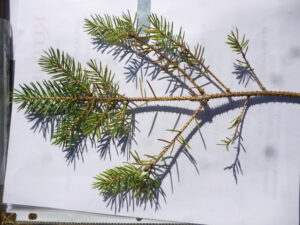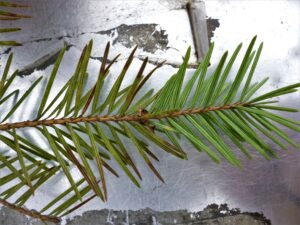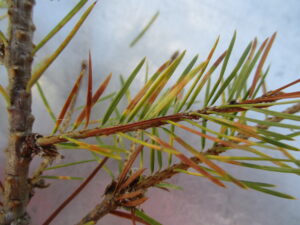In this edition:
- Insects – Pest Scouting with growing degree-days (250-600 GDD50)
- Scales
- Mites
- Diseases
- Needle casts (Rhabdocline and Swiss needlecasts – Douglas fir, & Rhizosphaera – spruces)
- Phytophthora
- Soil fertility – resources
Please click “read more” below to get updates on pests, diseases, and other important resources for the week of 5/15/2023.
Insect Pests
| Projected GDD50 accumulation as of 5/15/2023 | ||||||
| Region | Location | 15-May | 22-May | 29-May | 1-Jun | 1-Jul |
| Southern | Upper Deerfield (NJ50) | 403 | 495 | 606 | 659 | 1347 |
| Central | Howell / Freehold (NJ10) | 308 | 393 | 488 | 534 | 1157 |
| Northern | High Point (NJ59) | 243 | 298 | 369 | 404 | 897 |
| Forecast: 7-month NMME based seasonal climate forecast (USPEST.ORG) | ||||||
Please download and print the Rutgers Conifer and Christmas Tree Pest Scouting Guide and refer to this post “Obtaining your local growing degree-days (GDD)” for additional information. (See pest scouting guides for complete list of references – cited within lists below)
Please SHARE what you SEE!! If you see a pest, disease, otherwise interesting or troublesome issue please report it to the Working Group by following the QR Code on the front of the Pest Scouting Guides or by filling out this reporting form.
PESTS ON THE RADAR
| Group | Common Name | Scientific Name | GDD Min (50F) | GDD Max (95F) | Ref. | Developmental / Target Stage / Notes |
| Mites | Spruce spider mite | Oligonychus ununguis | 190 | 363 | 1 | Immatures/Adults |
| Leafminer / Midge / Fly | Douglas fir needle midge | Contarinia pseudotsugae | 200 | 400 | 3 | Adults emerge from soil |
| Adelgid | Cooley spruce gall adelgid | Adelges cooleyi | 200 | 310 | 4 | 1st galls visible – Spruce |
| Leafminer / Midge / Fly | Arborvitae leafminer | Argyresthia thuiella | 245 | 360 | 1 | Larvae Treatments (1st generation) |
| Sawfly – Wasp | Pine sawflies (Red-headed) | Neodiprion lecontei | 246 | 1388 | 1 | Larvae (1st generation) |
| Adelgid | Eastern spruce gall adelgid | Adelges abietis | 250 | 310 | 5 | egg hatch, galls begin forming (not a control target) |
| Mites | Pine eriophyid mites | Eriophyidae | 298 | 533 | 5 | Typical treatment window |
| Scale | Pine Needle Scale | Chionaspis pinifoliae | 298 | 448 | 1 | Crawlers (1st generation) – control target |
| Beetle | Turpentine beetle | Dendroctonus terebrans | 300 | 350 | 4 | Parent beetles colonizing brood material |
| Weevil | Pine root collar weevil | Hylobius radicis | 300 | 350 | 4 | 1st adults active |
| Adelgid | Hemlock woolly adelgid | Adelges tsugae | 350 | 350 | 1 | Eggs and 50% hatch |
| Scale | Elongate Hemlock Scale | Fiorinia externa | 360 | 700 | 1 | Crawlers (1st generation) |
| Caterpillar | Larch casebearer | Coleophora laricella | 363 | 618 | 2,4 | Nymphs active – typical treatment window |
| Leafminer / Midge / Fly | Pine needle midge | Thecodiplosis brachynteroides | 400 | 500 | 7 | Adults (1st generation) |
| Scale | Striped pine scale | Toumeyella sp. | 400 | 500 | 3 | Crawlers (1st generation) |
| Scale | Pine tortoise scale | Toumeyella parvicornis | 400 | 1000 | 4 | Crawlers |
| Caterpillar | Hemlock looper | Lambdina fiscellaria | 448 | 707 | 5 | Typical treatment window |
| Beetle | Pine shoot beetle | Tomicus piniperda | 450 | 500 | 4 | Adults emerge; begin shoot feeding – control target |
| Beetle | Pine Chafer (Anomela Beetle) | Anomala oblivia | 450 | 600 | 7 | Adults (1st generation) |
| Caterpillar – borer | European pine shoot moth | Rhyacionia buoliana | 480 | 710 | 5 | Larvae Treatment |
| Leafminer / Midge / Fly | Arborvitae Leafminer | Argyresthia thuiella | 533 | 700 | 1 | Adults (egg laying) – larvae treatments |
| Leafminer / Midge / Fly | Balsam gall midge | Paradiplosis tumifex | 550 | 700 | 4 | Galls apparent |
| Scale | Juniper scale | Carulaspis juniperi | 550 | 700 | 7 | Egg hatch |
| Caterpillar | Bagworm | Thyridopteryx ephemeraeformis | 600 | 900 | 1 | Larvae (early instars) – ONLY CONTROL WINDOW |
| Scale | Cryptomeria scale | Aspidiotus cryptomeriae | 600 | 800 | 3 | First crawler emergence |
| Adelgid | Cooley spruce gall adelgid | Adelges cooleyi | 600 | 1000 | 7 | Nymphs active – Douglas fir (control target) |
Scale insects – Crawler EMERGENCE:
- About: If you have areas with known scale insect problems, please keep a very keen eye on them. Typically, scale crawlers (mobile juvenile phase) have a cream to red to orange appearance and are by far the easiest stage to target for successful management of scale insects. Once the crawlers settle, treatment becomes exponentially more difficult. Crawlers can be observed with double sided tape, hand lens / loupes, and microscopes.
- Cultural management: Remove heavily infested trees prior to crawler emergence if at all possible. In many cases scale crawlers (once hatched) can be dislodged when moving and destroying infested trees. Application of treatments prior to moving these infested materials, may prove beneficial in high valued and trafficked areas. Additionally, monitoring for crawler activity or lack thereof may help reduce unneeded pesticide use. Also note, many scale insects can be killed, yet carcasses remain affixed to the bark or needles, and may require physical removal.
- Posts related to conifer specific scale insects and their cultural and chemical management
Other important insect pests
Spruce spider mites – “Miticide treatments should be concentrated during active periods from March through June & September through November. There are a couple dozen or more miticides labeled for use against spruce spider mites. Some of the reduced-risk miticides available include acequinocyl, bifenazate, Spinosad, & spiromesifen” – click here to continue reading “Spruce spider mites: a key cool season mite pest” (Steven K. Rettke – RCE)
Nantucket Pine Tip Moth – “For small populations, prune out the dying tips and destroy. If large populations are anticipated, then hang out the pheromone traps to monitor for the adult flight period. Adult NPTM’s are ¼ inch long, with gray wings mottled with rust-colored patches. When the first moth is caught, count 10 to 14 days, and apply acephate (Orthene), cyfluthrin (Tempo2), or fluvalinate (Mavrik). Imidacloprid (Merit) is effective when proper lead-time is provided (4 to 8 weeks with soil injections or drenches). Merit is usually not effective against caterpillars (i.e., therefore, the NPTM is an exception to the rule). Be prepared for a second generation in July” – click here to continue reading “Some early spring inset pests on Christmas trees” (Steven K. Rettke – RCE)
DISEASES ON THE RADAR
Needle cast diseases (adapted from Modified from Dr. Anne Gould’s post – “Needles may fall”

Rhizosphaera Needle cast – Spruce (Steven K. Rettke – RCE)

Swiss Needlecast – Douglas Fir (Steven K. Rettke – RCE)

Rhabdocline Needlecast – Douglas Fir (Steven K. Rettke – RCE)
- About: The infection period for needle cast fungal diseases occurs in the spring. These diseases affect new needles and will cause them to turn brown and fall off later in the season or in subsequent years. “There are at least 40 needle cast diseases in the United States; most affect pine, spruce, fir, larch, cedar, hemlock, and Douglas-fir. These diseases are caused by fungi that have only one infection period per year; in most cases (but not all), the new growth is infected by the offending fungus and, once the infection cycle is complete, is eventually cast from the tree (hence the name)”. “A week or two before bud-break, orange fruiting bodies develop within these spots on the lower needle surface. When the fruiting structures are mature, they rupture and release abundant spores (called ascospores) during wet weather. These spores infect newly expanding needles. “Once the needles fully elongate and the weather is warm and dry, ascospores are no longer released, and the needles infected the previous year are cast from the tree. Symptoms on the newly infected needles do not appear until the following fall or winter, and spores are not produced again until the following spring.” (Dr. Anne Gould).
- Douglas fir is susceptible to Rhabdocline and Swiss needle cast. Spruce trees, especially Colorado blue spruce, are extremely susceptible to Rhizosphaera needle cast problems.
- Cultural management:
- Use healthy stock and provide an optimal growing environment.
- Inspect trees during late winter/early spring and look for symptoms and signs. The pattern of infection will likely follow portions of the canopy or field where moisture in the canopy is most abundant.
- Remove sources of inoculum. For best results, remove old and severely infected (30% or more) trees prior to budbreak. Prune severely affected branches during dry weather, and disinfest tools between cuts with rubbing alcohol.
- Manage the moisture. Choose sites with good air drainage and promote rapid drying of needles through spacing and row orientation. In existing plantations, remove weeds and consider mulching. Avoid overhead irrigation if at all possible.
- Material considerations:
- For many needlecast diseases, begin chlorothalonil sprays when the first 10% of the trees in the planting first break bud (or the candles are about ½-inch long). Repeat the sprays twice more at 7- to 14-day intervals until needles are fully elongated or until conditions are no longer favorable for disease development. Add an additional spray to control Swiss needlecast when the weather remains wet. For all fungicides, thorough coverage is essential. Unless your product includes a spreader sticker, add one to enhance coverage.
- Other compounds labeled for control of one or more of these needlecasts include azoxystrobin, coppers, (ammonium complex, basic sulfate, cuprous oxide, hydroxide, salts), mancozeb, thiophanate-methyl, and combination products. Read and understand each label prior to use to guard against known phytotoxicity issues.
Phytophthora, Pythium, Phytopythium root diseases
- Compounds used to control Oomycetes (Phytophthora, Pythium, Phytopythium) are called Oomycides and are fundamentally different than those used for fungal and bacterial diseases. Therefor, proper identification is required, as a plant with a fungal root rot (ex: Annosum root rot) would require completely different materials. Contact the Rutgers Plant Diagnostic Lab for diagnostic services. Within available materials there are three main groups, which describe where they will work on the plant given the application technique. Cultural practices are always more important than materials, especially in this case.
- Please review this handout for material and cultural practice considerations – Oomycete considerations in the nursery (Phytophthora, Pythium, Phytopythium, Downy mildews)
- Management focuses around treating the roots, or providing materials that reach the roots.
- Protectants – are non-mobile, meaning they stay exactly where applied, must be root / drench / watered-in, applied.
- Xylem mobile systemics – move upwards, and the roots must be treated.
- Translaminar systemics – move very short distances into tissues, again meaning the roots must be targeted.
- Amphimobile/Fully systemics (P07 / phosphonate group)– can move upwards to needles (xylem) and down to the roots (phloem) meaning foliage or roots can be targeted.
Refer to each label for treatment intervalsas they vary greatly, however it is valuable to get ahead of this pathogen as very few materials can “cure” plants. Additionally, more than one material should be in your tool kit as Mefenoxam-resistance has been identified in the Mid-Atlantic region. Contact twaller@njaes.rutgers.edu for more information.
Do not apply group P07 and copper-based fungicides within 14d of one another, as phytotoxicity is likely to occur!
CHRISTMAS TREE FERTILITY
Managing Christmas tree fertility is an important way to keep your trees healthy and thriving through the season ahead. Testing the soil and/or having a leaf tissue analysis are the most accurate ways to determine which nutrients may be deficient and require fertilizer additions. The age of the tree will also influence the amount of fertilizer that is required for each tree. Now is a good time to test your soil and apply spring fertilizers if you have not done so already. Additional information can be found in this fact sheet “Soil Fertility Recommendations for Christmas Trees”.
NJ PLANT SPOTLIGHT
B. Errickson (Monmouth County RCE)
Our native NJ azalea species are currently in bloom, including dwarf azalea (R. atlanticum), pinxterbloom azalea, (R. periclymenoides), and swamp azalea (R. viscosum). These deciduous azaleas offer showy flowers that support pollinators and colorful fall foliage. As forest edge/understory plants, these species thrive in partial shade in well drained, acidic to slightly acidic soils.
Please SHARE what you SEE!! If you see a pest, disease, otherwise interesting or troublesome issue please report it to the Working Group by following the QR Code on the front of the Pest Scouting Guides or by filling out this reporting form.
Please note: The Rutgers Nursery and Green Industry Working Group is working to deliver regular pest and disease updates throughout the season. These will be in addition to important alerts, critical topics, and pesticide credit opportunities. This tool is made for you, the commercial agriculture business, so please let us know if there are particular topics you would like to see included in the regular update. Email: twaller@njaes.rutgers.edu Phone: 856-451-2800 Ext. 1.
DISCLAIMER: The label is the law, always refer to it for allowable host crops, use-restrictions, application rates, reapplication intervals, re-entry intervals (REI), application timing, and mix compatibility information. Production and pesticide information on this site are for private/commercial pesticide applicators and landscape professionals only, and are NOT for home gardener use. Provided materials represent examples and do not cover all possible control scenarios. Trade-names listed do not imply endorsement and are used as examples only. Please contact your local agent or chemical sales representative for more information or to discuss additional pest management options.

